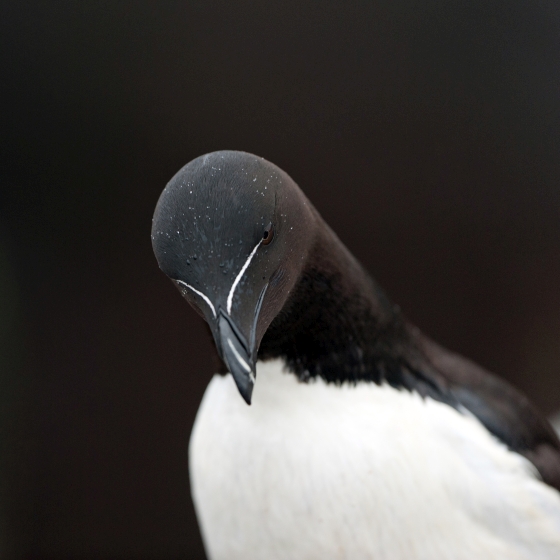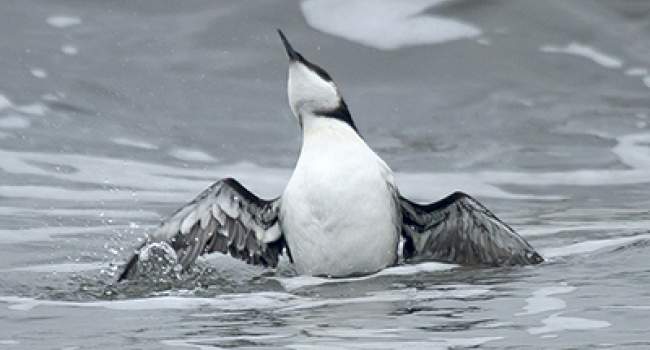Razorbill
Alca torda (Linnaeus, 1758)
RA
 RAZOR
RAZOR  6360
6360

Family: Charadriiformes > Alcidae

This striking bird, with its neat black and white breeding plumage, breeds in colonies alongside Guillemots and other seabirds.
Although the Razorbill shares a generally similar breeding distribution to Guillemot, absent only from those stretches of coast that lack suitable nesting cliffs, it has less exacting nest site preferences and occupies a slightly larger coastal range. Despite this, our Razorbill population is significantly smaller than that of Guillemot.
A significant proportion of the Razorbill population breeds here in Britain & Ireland, making our shores important in a global context.
Identification
Razorbill identification is usually straightforward. The following article may help when identifying Razorbill.
Identifying winter Auks

Summer Auks, in breeding plumage, at the shore or near to their colonies are relatively easy to identify. But in autumn and winter we tend to see them flying rapidly past, far offshore, or bobbing around in heavy seas offering poor views. When you add to this that their distinctive breeding plumage and colouring is lost, winter Auks can be a serious challenge to identify and separate.
SONGS AND CALLS
Listen to example recordings of the main vocalisations of Razorbill, provided by xeno-canto contributors.
Song
Develop your bird ID skills with our training courses
Our interactive online courses are a great way to develop your bird identification skills, whether you're new to the hobby or a competent birder looking to hone your abilities.
Browse training coursesStatus and Trends
Population size and trends and patterns of distribution based on BTO surveys and atlases with data collected by BTO volunteers.
CONSERVATION STATUS
This species can be found on the following statutory and conservation listings and schedules.
POPULATION CHANGE
The UK population increased by 40% between 1969–70 and Seabird 2000 (1998–2002). Annual counts from the Seabird Monitoring Programme suggest that numbers may have increased further since Seabird 2000, despite a shallow decrease during the first decade of the 21st century, although there are wide confidence intervals around these trends; data from the more recent Seabirds Count (2015–2021) should help confirm the recent trend once they are available (JNCC 2022).
DISTRIBUTION
Razorbills are largely pelagic in winter, yet were still reported around most of the coast of Britain & Ireland during Bird Atlas 2007–11. The breeding-season distribution is similar to that of the Guillemot, with breeding birds absent between Yorkshire and Dorset, where there is no suitable nesting habitat. The largest concentrations are from Flamborough Head to the Northern Isles and at many locations up the western seaboard of both Britain and Ireland.
Occupied 10-km squares in UK
| No. occupied in breeding season | 245 |
| % occupied in breeding season | 8.1 |
| No. occupied in winter | 482 |
| % occupied in winter | 16 |
European Distribution Map
DISTRIBUTION CHANGE
Change in occupied 10-km squares in the UK
| % change in range in breeding season (1968–72 to 2008–11) | -16.7% |
| % change in range in winter (1981–84 to 2007–11) | --10.5% |
SEASONALITY
Razorbills are recorded throughout the year, though more consistently during summer at suitable coastal breeding sites.

Movement
Information about movement and migration based on online bird portals (e.g. BirdTrack), Ringing schemes and tracking studies.
RINGING RECOVERIES
View a summary of recoveries in the Online Ringing Report.
Foreign locations of birds ringed or recovered in Britain & Ireland

Biology
Lifecycle and body size information about Razorbill, including statistics on nesting, eggs and lifespan based on BTO ringing and nest recording data.
SURVIVAL & LONGEVITY
View number ringed each year in the Online Ringing Report
Maximum Age from Ringing 
|
41 years 11 months 23 days (set in 2004) 
|
Typical Lifespan 
|
13 years with breeding typically at 4 year |
Adult Survival 
|
0.9  
|
Juvenile Survival 
|
0.38 (to age 4) 
|
BIOMETRICS
Wing Length 
|
Adults | 196.9±6.9 | Range 189–205mm, N=285 |
Body Weight 
|
Adults | 613±52.8 | Range 525–705g, N=266 |
Feather measurements and photos on featherbase 
CODES & CLASSIFICATION
Ring size 
|
Special |
Field Codes 
|
2-letter: RA | 5-letter code: RAZOR | Euring: 6360 |
For information in another language (where available) click on a linked name
Research
Interpretation and scientific publications about Razorbill from BTO scientists.
CAUSES AND SOLUTIONS
Causes of change
Although the UK population of Razorbills show an increasing trend, there are concerns about very low breeding productivity, particularly during the first decade of the 21st century. Low productivity is believed to be linked to food supplies, particularly of sandeels Ammodtyes marinus, which may be linked to sea surface temperatures and hence climate change. As Razorbills typically live for 13 years and can live for up to 40 years, low productivity is an early warning sign which can be expected to lead to population declines over the medium- to long-term, provided other factors such as survival remain constant.
Links to more studies from ConservationEvidence.com
- How to prioritize rat management for the benefit of petrels: a case study of the UK, Channel Islands and Isle of Man
- Supplementary feeding of young puffins, Fratercula arctica
- Post-release survival of oiled, cleaned seabirds in North America
Read more studies about Razorbill on Conservation Evidence >
Would you like to search for another species?











Share this page